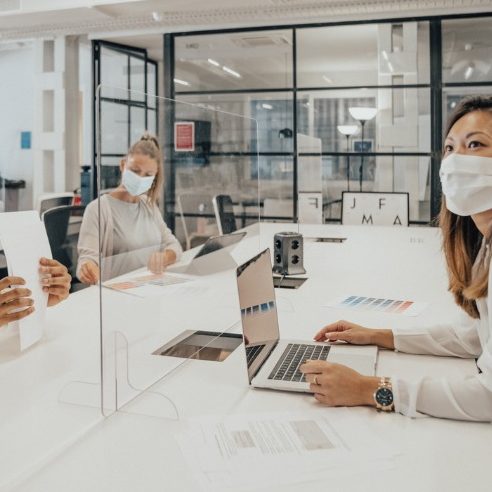Safety and sizzle are the goals
As restrictions ease, meeting professionals will be eager to get back to—well, meeting. Considerations for maintaining distancing and personal safety will offer challenges, but with them come opportunity to rethink the expected. So, how do you keep your team and attendees protected without sacrificing conversation, connection and overall experience?
Start with the Facts
According to the latest understanding of how the virus spreads, the likeliest transmission is via respiratory droplets spread from an infected person through breathing, coughing, sneezing, singing and talking. Virus-infected droplets build in the air and can congregate to higher levels over time. Being indoors in a poorly ventilated place in close contact (less than six feet) with other people is the worst possible scenario. Additionally, the longer the contact, the more infected droplets can build up and potentially cause infection.
Medical experts cite ventilation and fresh air, plus frequent sanitation and physical distancing, as keys to reducing the spread. For this reason, room setups should avoid stagnant grouping, reduce high-touch surfaces and provide adequate space as well as physical barriers to ensure safety.
Plan with Physical Distance in Mind
The first consideration is space. With the current new norm of six feet of distance between guests, you’ll need more of it. One solution provider is Allseated, which has designed physical distancing tools that allow you to create floorplans in the software company’s library of over 100,000 venues based on distancing recommendations. The algorithm can also be adjusted to reflect local regulations. The launch of the Allseated Connect Video Conferencing tool allows users to invite others into a floorplan (like a Zoom call) and to hold meetings virtually inside the layout. Users can also design the layout and make changes in real-time during the video conference with clients.
With this tool, planners can virtually tour and update designs down to the spacing of plates and silverware on the tabletop. The company traces its roots to the world of video games and puts that experience to work in designing tools that are user-friendly and technologically advanced.
Use Barriers
With seating and congregation areas planned, next come physical barriers. Meant to keep an infected person’s respiratory droplets out of another person’s space, physical barriers have become a new norm in retail settings, workplaces and other high-traffic areas where physical distancing is not always possible. So, the challenge: how to make Plexiglas and PVC dividers part of your design with branding or clever configurations.
USA Sealing is among companies providing an endless array of options, from rounded to square corners, freestanding to mounted structures, in clear or opaque versions. Surfaces can be tinted and printed with anything from logos to artwork. Plexiglas barriers mounted on wheels can be used to create customized gathering spots at a moment’s notice.
Where to put them? The answer depends on how long attendees or staff may be gathering in various areas. Of course, highest priority is employing them in any situation where one person, staff or attendee, will come face-to-face with many others—just as you’re seeing at grocery stores and pharmacies.
While round table setups with dials of Plexiglas in the middle may seem over the top, you might consider creating some tables or areas with such added protection to make especially wary guests more comfortable. For example, in their guide, “Considerations for Business Gatherings Post-COVID-19,” event company Freeman suggests creating multiple conversation pods with appropriately spaced seating and a screen between the two sides.
Be the Post-Pandemic Pioneer
The art and craft of creating meeting space will take more imagination than it did when you could place chairs seat-to-seat in multiple rows and call it a day. Creative standards for meetings that employ physical distancing without creating social distancing, however, are yet to be set—and there’s the fun challenge. Now is an opportunity to draw inspiration from technology, architecture and design to reconfigure preconceptions about how your attendees can connect safely in shared space.
Determine Traffic Flow

Directional markers (with distancing prompts) are another necessity. Designating one-way throughways will eliminate head-on foot traffic, reducing the likelihood of bumping into someone just as they let out a laugh or yell to a colleague across the hallway. But you don’t have to rely on the drab, instructional floor markers you see at the hardware store. And a row of plants can act as stylish and unobtrusive traffic dividers.
Plenty of companies are providing customized floor graphics, but you can also look to an unlikely source for crowd-control inspiration: Disney theme parks.
Disney “imagineers” created the term “weenie” to describe an architectural element in their parks that intuitively helps drive foot traffic in a predictable pattern. Cinderella’s castle is one of them. Consider using visual centerpieces and implementing design strategies to direct flow (in addition to cleverly marked decals) in potentially congested areas.
Think About Air Circulation
Proper ventilation is essential. The more dispersed air particles are, the less likely they will congregate in amounts sufficient to cause infection. Health guidelines suggest the risk of contracting the virus outdoors (while still employing physical distancing) is much lower. When planning for your event, make use of open-air spaces, retractable walls, and areas with large windows that open to enhance fresh-air circulation.
When those options aren’t available, don’t assume air filtration is up to par. Talk with your venue about their HVAC and practices. Have air filters been changed recently? Does the system recirculate indoor air (bad) or exchange it for fresh air from the outside (good)? Bathrooms are a special concern, as they are frequently without windows. In such small spaces, it’s crucial exhaust fans are in working order and filters are changed frequently.
Look for third-party certifications such as LEED or WELL, both of which have higher standards for air filtration.
Approach It Like a Designer
It’s not just about where you put the chairs. Room design will be more important than ever as we return to in-person gatherings. Attendees will expect the experience to be worth showing up in person—and to deliver more than information that could be digested through a screen.
So, think about ways new safety implements can be used to drive event messaging, branding and experience. Think, for instance, about cheekily phrased floor markers and dividers with printed decals. How can attendees interact with a space that doesn’t require long bouts of physical crowding?




